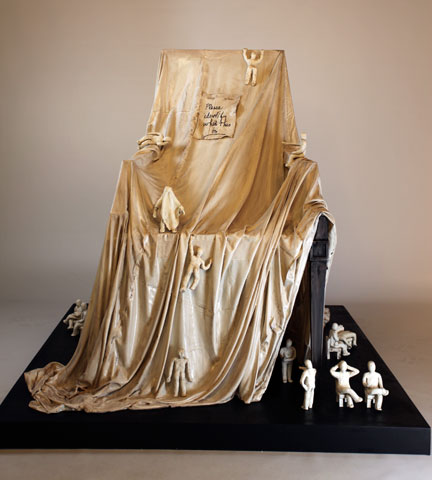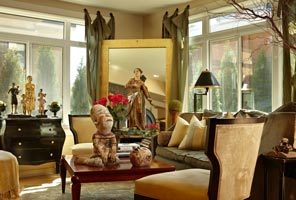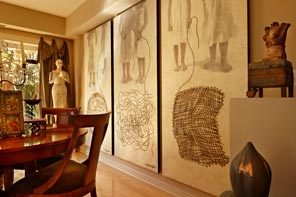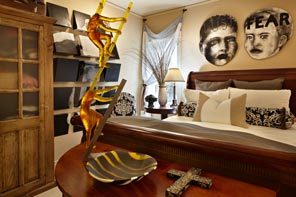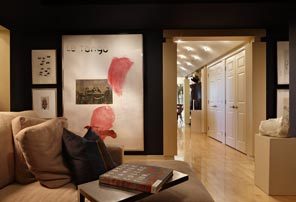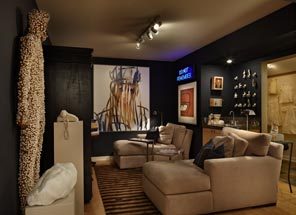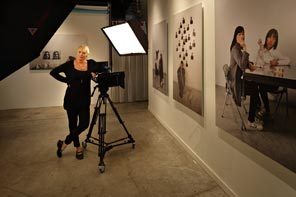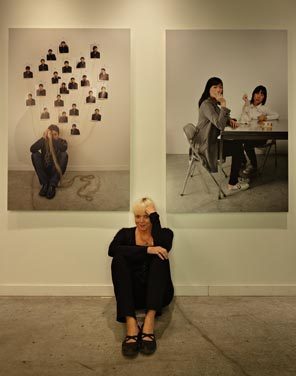|


(L to r) Artist Judith Kindler and interior designer Barbara Hyde Evans with the chair they transformed for The Chair Project Group Show. Photo courtesy of Judith Kindler.
By Katherine Luck
What happens when a mixed-media artist and an interior designer collaborate to create a one-of-a-kind chair? Will it become art, or will it still be something you can sit on?
That’s the line of questioning that led to the Chair Project Group Show, a partnership between Seattle Design Center and Pratt Fine Arts Center that teamed up artists and designers to create unexpected versions of the everyday household item.
“The idea started for me a little more than a year ago, wondering how we could create a dialogue between the art world and the design world,” said Craig Cross, marketing manager at Seattle Design Center. “For our industry, a chair is an iconic project. ... I was curious to see how many would come back looking like chairs.”
Read article at www.journal-newspapers.com.
The Journal Media Group
Archives > In This Issue > Home Improvement
Is it a chair ... or is it art?
A chair turned into a sculpture by Seattle artist Judith Kindler and interior designer Barbara Hyde Evans. Photo courtesy of Judith Kindler.
By Katherine Luck
Published: Monday, February 28, 2011 10:08 PM PST
What happens when a mixed-media artist and an interior designer collaborate to create a one-of-a-kind chair? Will it become art, or will it still be something you can sit on?
That’s the line of questioning that led to the Chair Project Group Show, a partnership between Seattle Design Center and Pratt Fine Arts Center that teamed up artists and designers to create unexpected versions of the everyday household item.
“The idea started for me a little more than a year ago, wondering how we could create a dialogue between the art world and the design world,” said Craig Cross, marketing manager at Seattle Design Center. “For our industry, a chair is an iconic project. ... I was curious to see how many would come back looking like chairs.”
Last fall, 10 local artists were matched with 10 interior designers, then given an identical chair to work on together. One team was formed by artist Judith Kindler and interior designer Barbara Hyde Evans. Though they had never met before the Chair Project, Evans was already a fan of Kindler’s art.
“I was really excited to be involved with the process. I wanted to see Judith create her art. ... From an interior design standpoint, [her art] works in every room,” said Evans.
“We [interior designers] use a lot of art in our homes. Getting a little more background about what is involved is terrific.”
Kindler and Evans picked up their chair in September. “It’s a very classic Baker chair. It’s got great lines, great curves,” said Evans.
“But it wasn’t a finished chair, though — just a frame,” added Kindler.
The two spent weeks working on the chair in Kindler’s studio, located on Mercer Street just across from Seattle Center.
“We had a lot of fun. We started out with a meditation. We put the chair on a pedestal with candles. We drank some wine and had some hors d’oeuvres, and when we were good and ready, we got started,” said Kindler. “As we were collaborating, you searched for things of yourself that you could put into a chair.”
The pair decided that the theme of their chair would be mystery and surprise; the act of unveiling something, explained Kindler. “What we cover and what we reveal — I like playing with the whimsy of it,” she said.
To that end, Evans and Kindler draped their chair with a cloth soaked in fiberglass resin. Then they covered and surrounded it with small figures that appear to be pondering the chair.
“Barbara was integral to the process,” said Kindler. “It was real hands-on.”
The artistic process was particularly laborious, according to both Evans and Kindler, due to the resin. Though this synthetic polymer is very durable and lightweight, “It’s very hard to work with. It sets up like that,” said Kindler, explaining that they had less than one minute to arrange the fabric before the resin became too stiff and hot to handle. The two, aided by Kindler’s assistant, had to rehearse how they would lay the cloth over the chair. Then came weeks spent carefully scraping away the puddled resin from the base on which the chair would rest.
In spite of the challenges, both Kindler and Evans enjoyed the process immensely.
“We’ve had a ball doing this,” said Kindler.
“We did a lot of giggling,” Evans agreed.
Part of the reason they made such a cohesive team may be their backgrounds.
“There was huge cross-over,” said Kindler, whose mother was an interior designer. “My family has been in the furniture business and I was in the furniture business for some time.” Kindler designed furniture and had her own textile lines for years, prior to her success as a multidisciplinary artist. Evans for her part has a bachelor’s degree in fine arts from the University of Washington. She moved to New York City and went into advertising instead of art, then returned to Seattle to open Hyde Evans Design in 1995.
The finished chair was due on Feb. 1. All 10 of the teams unveiled their chairs to the public on Feb. 12 during Seattle Design Center’s Northwest Design Awards Gala.
“One of the things we were enjoying is [how] some of the artists and designers took it more toward art; some took it more toward design,” said Kindler.
“Some of them are really reflective of the artist’s work. Some are a collaboration and some worked separately,” said Evans.
From functional chairs to pure art pieces, the 10 chairs are highly diverse in appearance. One was transformed into a “chair-delier” that hangs from a pole. Another was painted like a canvas. Others are swathed with gauzy fabric and have unexpected bits of sharp metal added to the frame, or have been carved into long-legged sculptures that would be hazardous to sit on. However, the majority still resemble furniture.
“I was surprised how many came back still looking like chairs,” said Cross. “I was wondering if there would be any similarities [among the chairs]. I was thrilled to see that there isn’t. They are all distinct.”
“When you look at my work then at the chair, it’s very identifiable,” said Kindler.
“I wanted it to look like Judith’s work,” Evans emphasized.
Their cooperative partnership wasn’t unique among the 10 teams.
“I theorized there would be some push and pull between artist and designer,” said Cross. He was gratified that so many of the teams worked well together. “A lot of the groups have had a lot of fun with it. … It speaks volumes to what the collaboration was really all about.”
Following the public presentation on Feb. 12, the chairs move to Nordstrom’s window at 5th and Pine, where they will be displayed March 8 through April 5. The chairs will then be sent to McCaw Hall for six weeks. The chairs will be auctioned off in August.
“The grand thing about this whole [project] is when these chairs finally go to the auction, the proceeds go to Pratt, which is such a wonderful organization,” said Kindler. Pratt is the only facility in the Northwest where beginning and established artists work side-by-side to create art using a wide range of media, including glass, metal, stone, wood and paint. Classes are offered at this 35-year-old nonprofit to over 3,500 students and its studios serve more than 500 working artists each year. Both Evans and Kindler have a special connection to the center: Evans’ son took classes at Pratt and Kindler is on their board of trustees.
Though the work on the Chair Project may be done, it’s still inspiring the participants. In the past, Kindler had created sculptural art featuring small figures and draped fabric hardened with resin, but “I had not done it to this scale. I found it so inspiring that I’m rolling out a whole new line of work.”
“Design gets a little entrenched in its little bubble. We’ve got to break through the bubble into the wider world,” Cross agreed, adding that Seattle Design Center is interested in undertaking this kind of project again. “It’s a good, healthy direction to pursue. Now that we’ve flirted with getting out of our bubble, how do we keep it going?”
__________________________________________________________________________
- Originally published Saturday, December 4, 2010 at 7:04 PM Seattle Times
Northwest Living
Seattle artist Judith Kindler surrounds herself with creativity
Judith Kindler and her husband, attorney Kyle Johnson, live in an art-filled condo on Lower Queen Anne. The couple have long been involved in Seattle's art scene. They established the Judith Kindler and A. Kyle Johnson Scholarship for Innovation in the Visual Arts at Cornish College of the Arts. She sits on the board at Pratt Fine Arts Center. A former board member of Poncho, she was its 2009 Artist of the Year.
By Rebecca Teagarden
Judith Kindler and Kyle Johnson's collection of antique santos preside in the living room of their condo. On the cocktail table sit ceramic sculptures, including one by Akio Takamori.
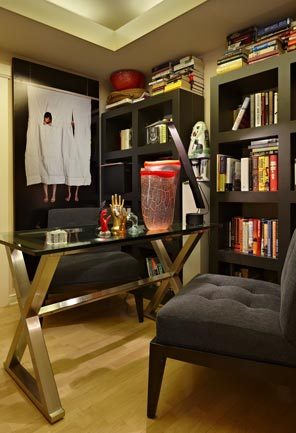
photographed by Benjamin Benschneider BENJAMIN BENSCHNEIDER/THE SEATTLE TIMES
BENJAMIN BENSCHNEIDER/THE SEATTLE TIMES
Judith Kindler in her studio with two photographs from her new series, "Don't Hate Me Because I'm Beautiful."
BENJAMIN BENSCHNEIDER/THE SEATTLE TIMES
The den, which Kindler calls "Kyle's room," offers cavelike comfort. It features work by Deborah Oropallo (back wall) and a neon by Ingrid Lahti as well as other pieces, including a sculptural installation by Kindler (right wall). The large figure is by sculptor James Croak; the marble head nearby is by Sabah Al-Dhaher.
BENJAMIN BENSCHNEIDER/THE SEATTLE TIMES
The master bedroom is a study in black and white. Over the bed is Layne Kleinart's "Lust and Fear." On the wall is a Chris Gay piece. A Dan Webb sculpture climbs in the foreground.
BENJAMIN BENSCHNEIDER/THE SEATTLE TIMES
The warm, creamy dining room features an encaustic and mixed-media triptych by Kindler and a Luis Sanchez sculpture (forefront). Near the window is an antique santo from the couple's collection of them.
BENJAMIN BENSCHNEIDER/THE SEATTLE TIMES
Julian Schnabel's "Le Tango" dominates a wall in the den. Next to it are pieces by Francesco Clemente and Juan Alonso. Down the hallway sits a Julie Speidel bronze.
BENJAMIN BENSCHNEIDER/THE SEATTLE TIMES
Judith Kindler in her studio with pieces from "Don't Hate Me Because I'm Beautiful." Kindler and her husband, Kyle Johnson, have long been involved in Seattle's art scene. The couple established the Judith Kindler and A. Kyle Johnson Scholarship for Innovation in the Visual Arts at Cornish College of the Arts. She sits on the board at Pratt Fine Arts Center. A former board member of Poncho, she was its 2009 Artist of the Year.
BENJAMIN BENSCHNEIDER/THE SEATTLE TIMES
The library, just off the kitchen, holds a large photograph by Kindler and glass pieces from artists at Pratt Fine Arts Center.
BENJAMIN BENSCHNEIDER/THE SEATTLE TIMES
Guests in the Kindler home sleep in down-filled comfort surrounded by paintings. Here it's Rachel Maxi (left wall) Luis Sanchez, Judith Kindler, Anne Siems, Catherine Eaton Skinner, Barbara Wollner and others (back wall), and Molly Norris (right wall).
Galleries to hop to
Judith Kindler exhibits her work across the country through these galleries:
Gail Severn Gallery in Ketchum, Idaho; Gebert Contemporary Art Gallery in Los Angeles and Scottsdale; Melissa Morgan Fine Art Gallery in Palm Desert; Forré & Co. Fine Art in Aspen; Daniel Kany Gallery in Portland, Maine; and SAM Gallery in Seattle. She also was a shortlist finalist in the 2010 London International Creative Competition. Learn more about Kindler's work at www.judithkindler.com.
JUDITH KINDLER rushes to the door of her spacious Lower Queen Anne art studio, Atelier 31, where she's working to finish two shows at once. But Runkles, her kinetic Boston terrier/French bulldog, beats her to it.
Inside is a world photographed, captured in encaustics, bent in wire, molded, formed, fantastical, mysterious, beautiful, funny, strange, complicated, simple, old and modern. Bare white walls and concrete, buried beneath bunnies and pretty girls in dresses, a giant hot dog, birdies, more. Kindler and her assistant, Dino Martini, put in long hours at Atelier 31 producing work that is in demand.
Home is nearby, a brisk walk with Runkles. And if you think the artist would prefer to leave her work at the office, be prepared to be overwhelmed.
Kindler's life is made more rich by having art everywhere her eye might fall, her fingers might reach. It is her work and her obsession. Each evening, Kindler and her husband, attorney Kyle Johnson, open the door to their 2,000-square-foot condo and are greeted by Anne Siems, Scott Frish, Kiki Smith and Dan Webb. From their place on the wall, Kindler's own collection of white baby dresses billows in the breeze off the patio. But the billow is permanent. The dresses are waxed. If gazing is good, feeling is better. "Touch these," she says.
Turn the corner into the den and there is a commanding Julian Schnabel. Then it's a life-size stone man by James Croak, and an Ingrid Lahti, Deborah Oropallo, Squeak Carnwath. This is how it goes. In a tour of her home, Kindler points out the art. Furniture, big, comfortable, classical, fills the spaces in between.
Any place art fits it goes. If it doesn't, room is made. The Frish in the guest bath is behind the door. Just off the kitchen stands a substantial Julie Speidel bronze. And on it goes like this. Faye Jones, Rachel Maxi, Molly Norris, Steve Jensen. "We do rotate, and we've got a ton of stuff stored," she says, with a whaddayagonnado look. It's darned near impossible to pause and appreciate everything. Kindler guesses there are 350 works in the house and more than 700 in their collection.
So it seems odd that while the rest of the home is all art all the time the refrigerator remains a big blank canvas — except for two things: a small photo of Kindler and Johnson, and a postcard of Frida Kahlo and Diego Rivera. "She has been very instrumental to me in a very personal way," Kindler says of Kahlo. "Kyle and I were in Mexico a few years before the Frida Kahlo craze. We stumbled upon this woman in Zihuatanejo who ran a private museum. She took us on a backroom tour of Frida Kahlo's life through an artist's work. Kyle and I bought up every book we could find. "I have always been hiding behind humor," Kindler says. "Seeing the strength she had visually to reveal her pain helped me do that. Being open to letting people see more into me. "She's on here to remind me to open up; we all have these similar emotional experiences."
Passing a collection of santoses, Kindler says, "Each room has its own little sacred area. I like iconic figures. My work tends to iconic figures. When you look at defining truth, a single figure or a trinity, it's all referencing that religious iconic art." Technology is hidden behind doors, in armoires. Terraces, each an Italian scene, wrap three sides of the condo.
Kindler and Johnson used to live in Kirkland. This suits them better. "Being downtown, I live near everything that makes me alive."
Rebecca Teagarden is assistant editor of Pacific Northwest magazine. Benjamin Benschneider is a magazine staff photographer.
_________________________________________________________________________
July 2010
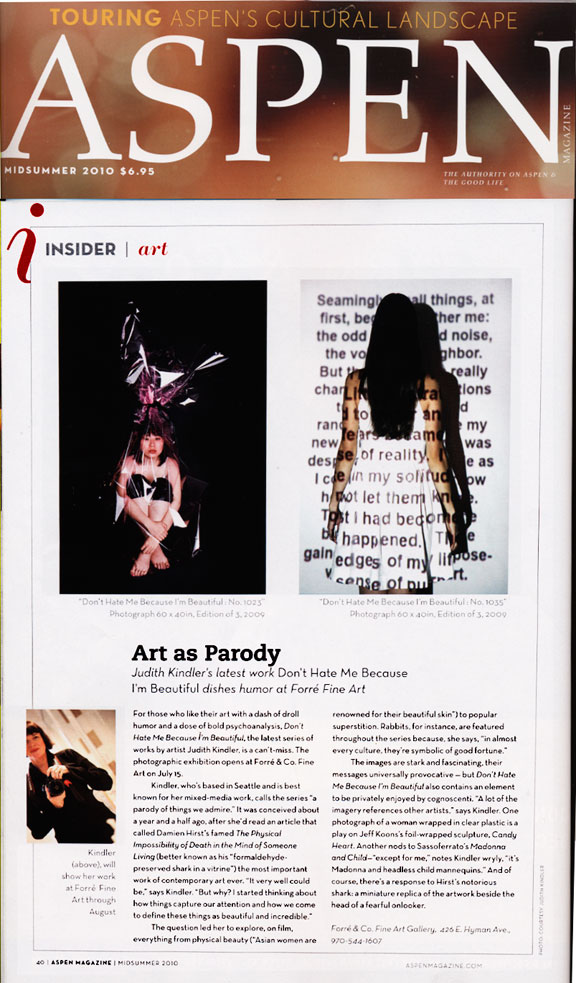
Friday, March 7, 2007
JUDITH KINDLER UNVEILS "SUN VALLEY MEMORIES"
By Karen Bossick
The WoodRiver Journal, Ketchum, ID
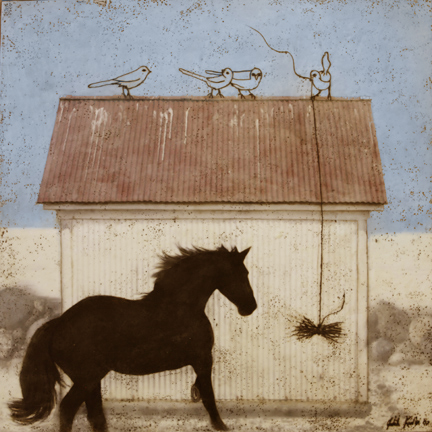
“Consume” was the name given to Judith Kindler’s last body of work. It defines Judith Kindler, the artist, as well.
Kindler, who divides her time between Sun Valley and Seattle , is consumed by her work. So much so that she will spend two or three years pondering one specific topic and creating art to express the thoughts running through her head.
Her latest exhibition, on display at the Gail Severn Gallery, is a break from that. Titled “Sun Valley Memories” (or “Recent Works”), it is a lighter look at the beauty Kindler finds all around her when she leaves the hubbub of Seattle for the calm of the Wood River Valley.
For me, this is the most relaxing place in the world. And these pictures show that,” says Kindler, who first became acquainted with Sun Valley 30 years ago.
“Sun Valley Memories” has its genesis in that now-legendary New Year’s Day two years ago when it snowed and snowed and didn’t stop snowing until the valley had been blanketed in two feet of billowy softness.
Driving south of Bellevue , (in Camas Prairie at a friends ranch) Kindler couldn’t resist . . . (taking pictures of the horses) . . . hulking shape(s) softened by the snowfall. “It was so magical,” she says.
She continued to add to her portfolio – a house on the Camas Prairie, more horses, a barn…
“This particular work was about letting go,” she says. “I wasn’t over analyzing as I tend to do. I was just fixated on these incredible things around us and the beauty.”
Kindler manipulates each photo digitally to get the exact look she wants. Then she prints a large0scale photograph with the help of a large format printer 44 inches wide, transferring the images onto a canvas nearly as tall as she. Next she layers encaustic painting over the digital photography.
Encaustic, she notes, is one of the oldest art mediums there is. It involves and ancient technique of painting with a molten resin mixed with beeswax. Kindler uses a heat gun, which looks like a hair dryer, to create different surface effects. And she inscribes and burns drawings onto the outer surface, taking care to be meticulous in her timing to avoid damaging lower layers.
Over the photographs she adds her signature narrative iconography with paintings and mark-making. She draws envelopes around horses, strings tangled between birds, branches wrapped around the feet of a little girl. Each are symbolic – the bottles representing illusion, the birds representing the voyeurism of the viewer, the cages representing social conditioning.
Intertwined with the photography, they work to unveil emotions, fear, insights, premonitions and intellectual struggles. And the depth the combination of materials presents asks viewers to look through the transparent layers to see what’s hidden beneath.
The process, which combines one of art’s oldest mediums with one of art’s newest mediums, couldn’t have been done even 10 years ago, says Kindler. “What’s wonderful for me is that the wax process is very process-oriented. There are lots of surprises along the way,” says Kindler who finished her work in a studio in the Gail Severn Gallery building rather than in Seattle so it would be ready for this exhibition.
Kindler grew up in Buffalo in a creative family. Her grandfather was a furniture designer and her mother an interior designer. Visiting art galleries in the greater New York area was part of the family routine.
“I can’t remember a time when I didn’t paint,” she says. “My mother always referred to me as “the artist.” At age 9 I transformed my bedroom into an art studio – with my mother’s blessing.”
Kindler developed an eclectic love of art that shows in her personal collection, which includes works by Francesco Clemente, Kiki Smith, Julian Schnabel and Julie Spiedel.
And, as a philosophy minor at Kent State , she also developed a compulsion to make the thought process part of her work. She’s explored such ideas as memories, dreams, and alter ego in her art. A series called “Defining Truth” emerged from her struggle to try to justify war.
She got the idea for “Consume” when she became disgusted at the way she consumed. She began asking questions, like: How do we consume? How does it define us? And how does the media undermine family values?
And she created art that expressed her views about consumer marketing to children. Headless child mannequins interacted with typical childhood toys and foods. Ten hamburger patties stacked between two buns asked, “When is Enough Enough?”
“I thought I had all the answers. But I did a ton of research. And I became less judgmental than when I started. I concluded there can’t be culture without consumption.”
Kindler will have 23 pieces in the show opening Friday at Gail Severn Gallery. Not all will be “Sun Valley Memories.” There are, for instance, three panels of a young woman in which Kindler has focused on the movement of the arms, the shadows, the abstraction of the dress.
“Simple iconic imagery,” she says.

Kindler's dreams take wing at Anne Reed
by MICHAEL AMES
The Idaho Mountain Express - February 7, 2006
| 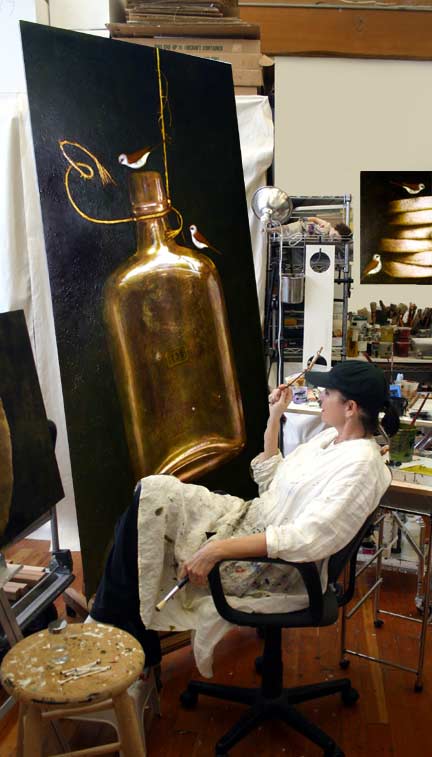
Judith Kindler working in her studio in Seattle. The piece on the easel is "Dream 139." (Below: "Dream 138")
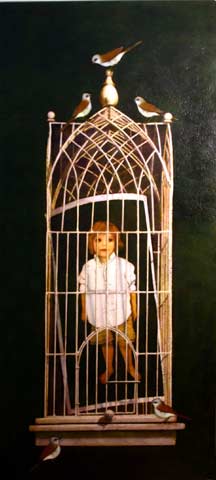
|
|
Judith Kindler's show opened Feb. 1 and will remain on display through the first week of March at the Anne Reed Gallery in Ketchum. Meet Kindler and discuss her work at the Feb. 17 gallery walk, from 6 to 9 p.m. |
Maybe it's Hitchkock's fault. But an overabundance of winged creatures always seems dangerous.
In Judith Kindler's solo show, "The Dreams," little birds seem to be everywhere, and their intentions are unclear.
As their creator, Kindler does not jump to defend them. Rather, she admits to inviting them into "The Dreams," a body of work nearly two years in the making, precisely for their unpredictable ways.
"The birds fulfill for me what the human figure does," she said, noting the birds' propensity for intelligent, yet mischievous behavior in "The Dreams."
In the large-scale encaustic works, Kindler's birds can be seen as either benign guests—such as when they perch atop a stack of crumpets—or malevolent little intruders, ready to untie precariously dangling glass jars and bottles. They never fly, but instead seem to be in a state of perpetual loitering.
In "Dream 138," the birds take on a more overtly insidious nature as they stand sentry over a small boy who has found his way behind the bars of a birdcage. Or have the birds trapped him?
The themes raised by Kindler's dreamscapes are, like dreams themselves, fittingly ambiguous. In the spirit of the greatest surrealists, Kindler brings her formidable painting and drawing talents to bear on "The Dreams." (She studied painting and sculpture at Kent State in the late 1960s and, yes, she "was literally there," when the school's infamous National Guard shootings took place.)
Working from large-scale printouts of digital photographs, she creates breathtaking recreations of the smallest detail of an everyday object, such as cloth, paper or a shaving brush. Always contrasted against dark backgrounds, Kindler has combined the Renaissance-era technique of "chiaroscuro" with the modern benefits of digital photography and printing. The marriage of the two has a way of enshrining banal objects in classically surreal, meditative states of grandeur.
"I reject the idea of decorative," Kindler said. Yet she also concedes that the thematic tensions present in "The Dreams" are only "simple narratives," usually introduced by the birds.
What is apparent, when viewed in relation to her entire body of work, is that these are not Kindler's most difficult paintings. In "Defining Truth," her previous solo show, she confronted harder issues, such as the loss of innocence and society's inherent sexism towards young girls.
While Kindler says she rejects the purely decorative, the encaustics of "The Dreams" are nonetheless accessible, aesthetically appealing works of art. They are painted with an earthy, soothing palette and are not, despite the skin-deep narratives presented by the birds' mischief, decorative works.
With more than 25 years of experience split between fine art and designing textiles, furnishings and art-based marketing strategies, Kindler is steeped in art that sells; she can't help but create appealing compositions. Her high-end painted fabric has sold for as much as $150 per yard and hangs in some of Las Vegas' plushest penthouses.
In her fine art painting, Kindler will and has pushed her own thematic limits, sometimes veering into more complex psychological or social issues than are evident in "The Dreams." The fact that her current exhibit is sweeter eye candy than others says more about the Ketchum art world, however, than it does anything about Kindler's often-compelling work.
The question arises: Does easy work seek a home in Ketchum, or do local galleries court accessible, safe art that is sure not to offend?
The showplaces and spaces of the Sun Valley Gallery Association rarely house the confrontational, edgy work so common in their metropolitan counterparts. It is unclear whether this is a conscious decision made by gallery owners and artists or if it is simply an idiosyncrasy of the local art environment.
With many customers coming through the galleries on vacation, difficult art may be repellent to eyes seeking refuge from the accosting images ubiquitous in big cities.
FThe Idaho Mountain Expressortunately for Kindler, she is an established artist with followings both in town and country. No stranger to the city, she has had recent shows in Seattle, Portland and Scottsdale, Ariz. In 1998, Kindler opened the doors of Atelier 31, her own studio turned innovative gallery space where clients can witness her artistic process firsthand.
Having visited Sun Valley for 26 years, Kindler understands the draw of the quiet community. As for showing her own work here, though, she waited for the right time.
"The gallery scene has come to a level where it is appropriate," she said.
Copyright © 2006 Express Publishing Inc.
The Idaho Mountain Express is distributed free to residents and guests throughout the Sun Valley, Idaho resort area community. Subscribers to the Idaho Mountain Express will read these stories and others in this week's issue.

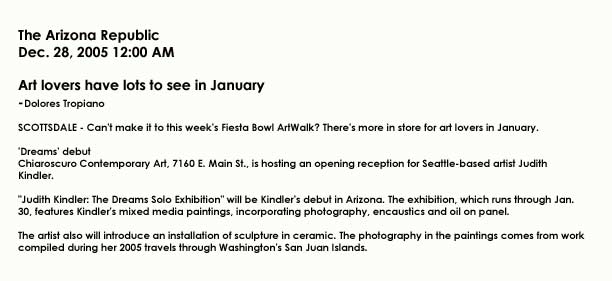
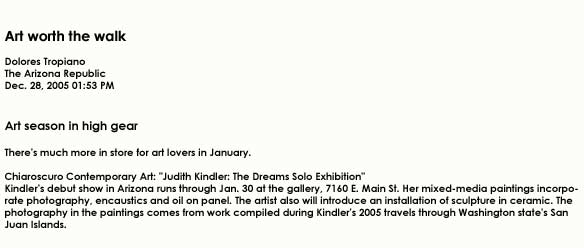
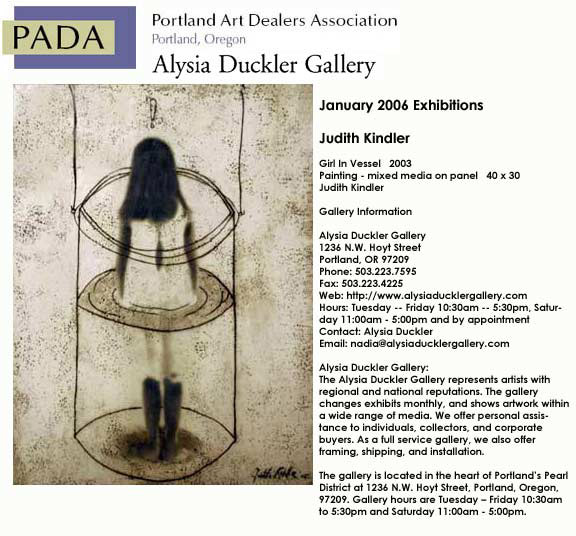
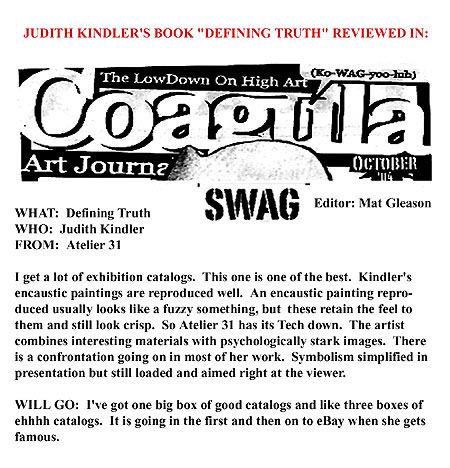
Kindler art Featured in article on Howard and Lynn Behars new home
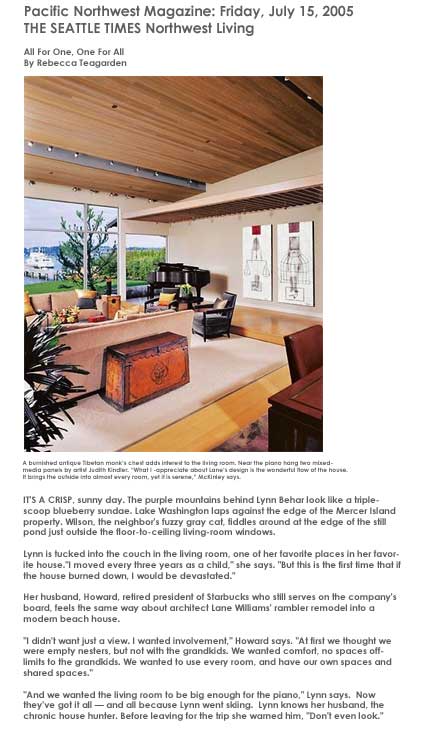
Reviews on "The Journal"
http://www.seattleartists.com/main/calendar/display_event.asp?ID=661®ion=1
| Cornish College Main Campus | The Journal - Judith Kindler, Sculpture & Mixed Media |
|
Event Type: Gallery Exhibition
5/10/2005 thru 6/10/2005 |
Cornish College Main Campus
1000 Lenora St.
Seattle , WA 98121 [map location]
The Journal
Judith Kindler Exhibits Work at Cornish College of the Arts
May 10 - June 10, 2005
Opening Reception: Tuesday, May 10, 6-8 pm
Gallery, Seventh Floor
Cornish College Main Campus Center, 1000 Lenora Street, Seattle
Exhibit Hours: Monday – Friday, 10 am-5 pm.
Free and open to the public. For information, please call 206.726.5011
Cornish College of the Arts is pleased to present The Journal, an exhibit of recent works in sculpture and two dimensional mixed media by Judith Kindler. The Journal is on view from May 10 through June 10, 2005, with an opening reception on May 10th from 6-8 pm.
Inspired by her journals from the past 30 years, Kindler documents questions she has asked of the I Ching (Book of Changes). The use of the I Ching accesses an ancient Chinese tradition, using a philosophical understanding of one’s position in relationship to a question posed. Revealing the trials and reflections of daily life, her work considers journal keeping as an ongoing dialogue with oneself. Through visual exploration, the artist exposes the commonality of the human experience, our search for answers and insight as well as our blindness to personal failings.
Judith Kindler is a visual artist whose work has been selected for inclusion in the PONCHO Art Auction, and was awarded Best in Show at the Bellevue Art Museum. She has exhibited broadly in the Northwest, including at Seattle’s Atelier 31 Gallery, Bibati Gallery in Portland, Oregon, Ann Reed Gallery in Sun Valley, Idaho; as well as at Vancouver, B.C.’s Buschlen Mowatt Galleries.
Kindler has served as a trustee of Cornish College of the Arts since 2002. Kindler was Co-Chair of Bellevue Art Museum Art Auction in 2002, and sat on the Executive Committee of the Contemporary Arts Council of the Seattle Art Museum. She was appointed by Virginia Anderson, head of Seattle Center, to sit on the Task Force to develop a Theater District and to serve on the Advisory Committee to oversee the development of the Theater District. Kindler is also a member of Kirkland’s Tourism Task Force and the Arts Commission Task Force of Kirkland.
Judith Kindler will donate half of the proceeds from sales of works in this show to the Cornish Endowment Fund, which provides scholarships to the next generation of artists.
http://www.takepartinart.org/index.aspx?s=pd&id=299
Cornish College of the Arts
The Journal: Judith Kindler Exhibits Work at Cornish College of the Arts
May 10, 2005 - June 10, 2005
Opening Reception: Tuesday, May 10, 6-8 pm
Cornish College of the Arts presents The Journal, an exhibit of recent works in sculpture and two dimensional mixed media by Judith Kindler.
The Journal is on view from May 10 through June 10, 2005, with an opening reception on May 10th from 6-8 pm.
Inspired by her journals from the past 30 years, Kindler documents questions she has asked of the I Ching (Book of Changes). The use of the I Ching accesses an ancient Chinese tradition, using a philosophical understanding of one’s position in relationship to a question posed. Revealing the trials and reflections of daily life, her work considers journal keeping as an ongoing dialogue with oneself. Through visual exploration, the artist exposes the commonality of the human experience, our search for answers and insight as well as our blindness to personal failings. |
|
|


